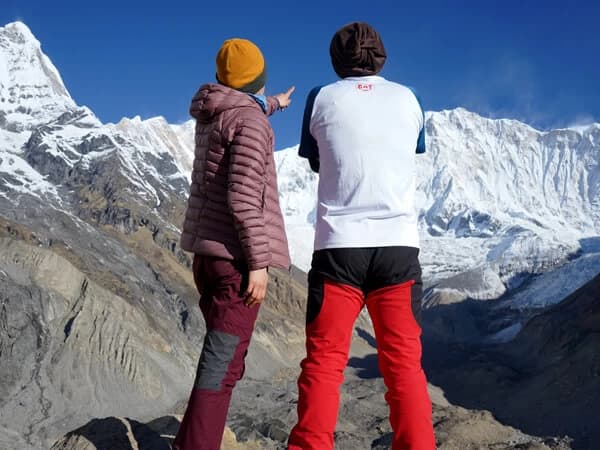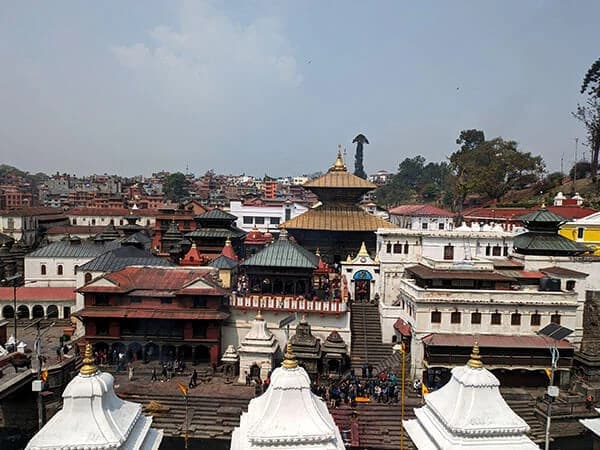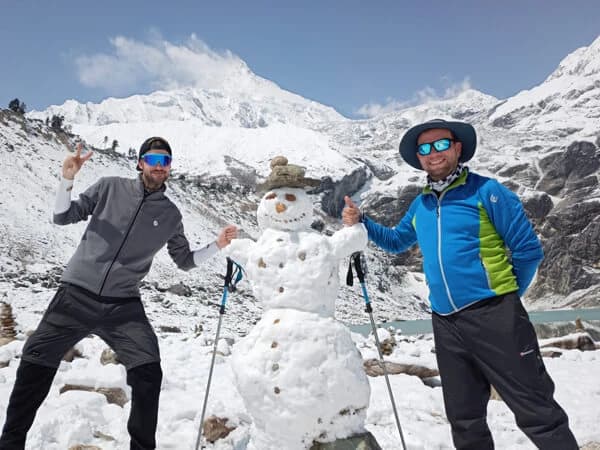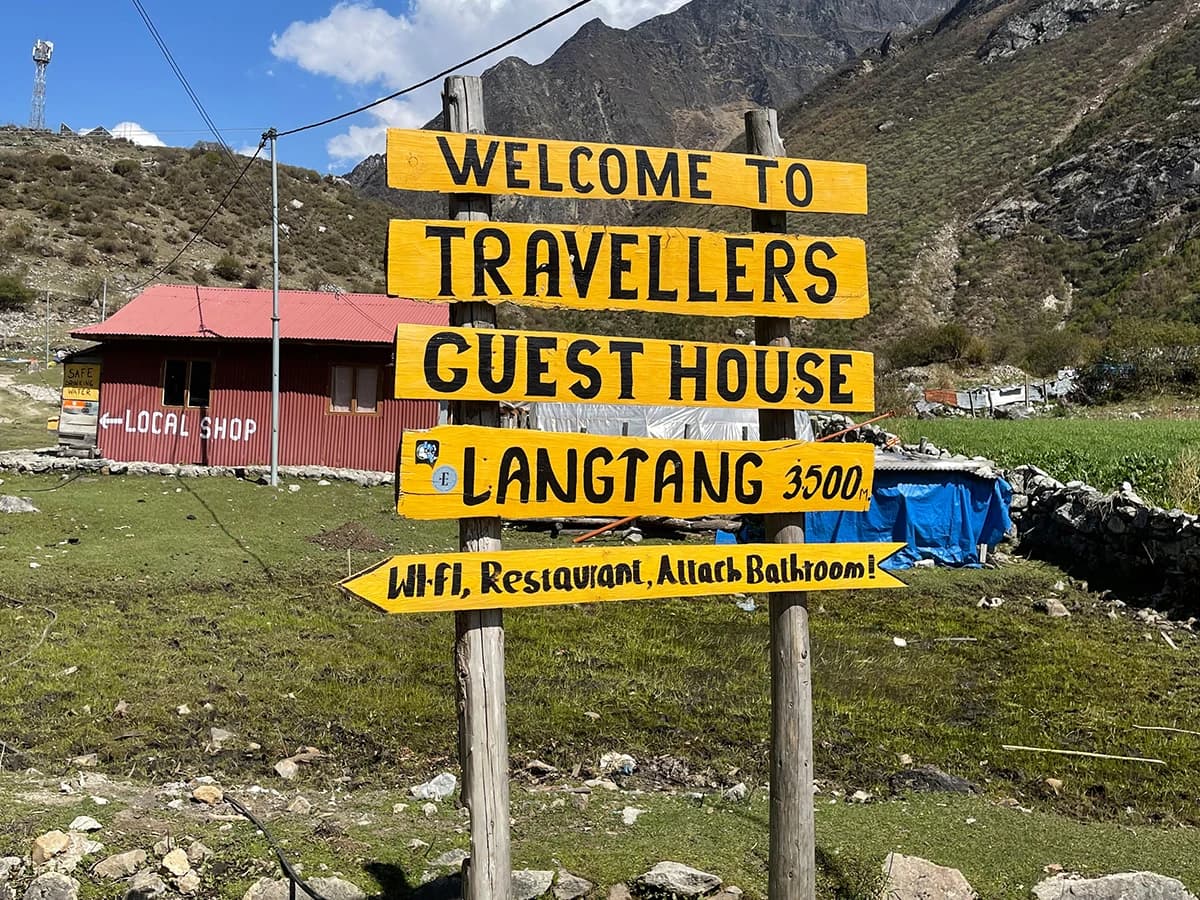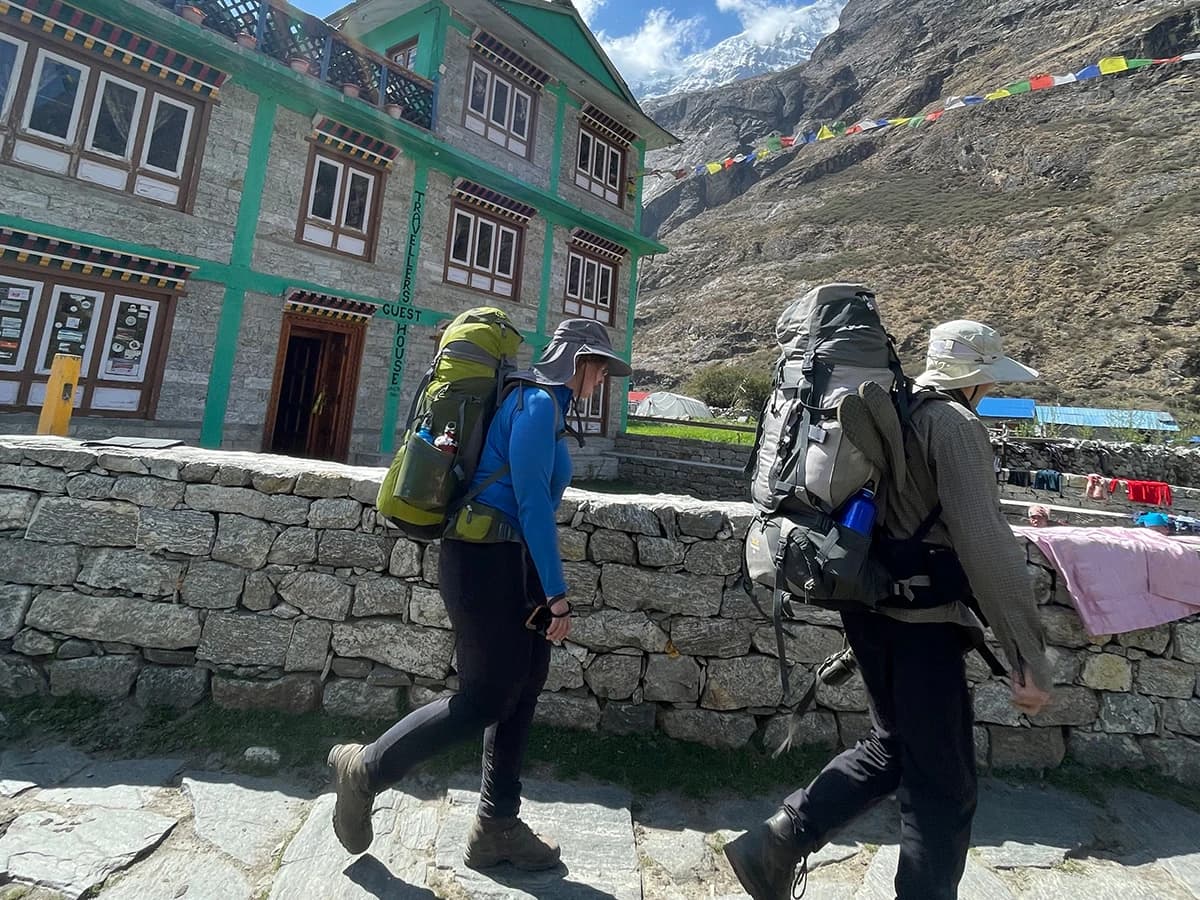The 12-day Langtang and Gosaikunda trek takes you to two of the most pristine destinations in the Himalayas. This journey blends the adventures along the dramatic Langtang Valley with the pilgrimage to the sacred Gosaikunda Lake. Enjoy breathtaking panoramic mountain views, adventurous trails, and rich cultural immersion in Tamang and Sherpa villages.
Langtang and Gosaikunda Trek – 12 Days
Langtang and Gosainkunda Trek Overview
The Langtang and Gosainkunda Trek is among the most rewarding short-duration treks in the Himalayas. Your journey begins with a scenic drive from Kathmandu to the gateway of the Langtang region. On this diverse teahouse trek, you will traverse dense subtropical forests, alpine meadows, charming Sherpa and Tamang villages, and trek alongside the serene rivers.
The Langtang Gosainkunda Trek is divided into two sections. The first is the trek to the U-shaped Langtang Valley. Here, you will explore the cultural center of the Langtang region at Kyanjin Gompa as you traverse through the Tamang Heritage Trail. During your journey, you will also conquer the 4,984-meter Tserko Ri and enjoy panoramic views of Langtang Lirung (7,234 meters), Dorje Lakpa (6,966 meters), and the Ganesh Himal (7,422 meters) and its breathtaking massif.
Likewise, after a successful ascent of Tserko Ri (5033 m), you will continue toward the pristine emerald high-altitude lakes of Gosainkunda. Believed to be created by the Hindu deity Lord Shiva to quench his thirst after drinking poison, the Hindu and Buddhist communities consider this lake a sacred pilgrimage.
Our Langtang and Gosainkunda Trek itinerary is a seamless mix of cultural immersion and Himalayan adventure, prioritizing your safety and well-being. On this classic Nepal trekking route, you can take in the diversity of the Nepali Himalayas by experiencing the local culture and stunning landscape.
Be a part of an unforgettable journey. Book your Langtang and Gosainkunda trek today!
Why go on the Nepal Langtang and Gosainkunda Trek?
The Langtang Gosainkunda trek is a comprehensive Himalayan experience. This trek blends Himalayan explorations, scenic mountain views, and cultural immersion, allowing you to dive deep into the heart of the Himalayas.
Here are the top reasons to choose the Langtang and Gosainkunda Trek in Nepal.
Cultural Immersion
The Langtang Gosainkunda trek takes you into the heart of the Sherpa and Tamang communities. Inspired by Tibetan Buddhism, the people of these communities have preserved their culture, traditions, and heritage. While traveling from one traditional village to another, you will encounter ancient monasteries like the Kyanjin Gompa and another ancient Gompa at Syabru Village to witness their unique lifestyle. A unique cultural immersion and local connection make the Langtang Gosainkunda trek more than just an adventure in the Himalayas.
Scenic Landscapes
On the 12-day Langtang Gosainkunda trek, you will pass through varying landscapes ranging from subtropical forests to rugged alpine meadows. Your journey comprises a walk along lush bamboo and rhododendron forests in the lower Langtang National Park region to rugged Himalayan terrain and glacial moraines in the upper valley. The contrast in landscape and scenery makes this trek one of the most beautiful treks in Nepal.
Beautiful Himalayan Vistas
The Langtang and Gosainkunda Lake trek offers opportunities to take in the stunning Himalayan views. On most parts of the trek, you have the icy giants as your backdrop. Additionally, the vantage points of Tserko Ri and Laurebinayak take you closer to the mountains, where you can get stunning views of Langtang Lirung, Ganesh Himal, Dorje Lakpa, and Manaslu.
Accessible Himalayan Adventure
The Langtang region is located near Kathmandu, making this trek easily accessible from Kathmandu. Additionally, this is a moderate trek that is suitable for trekkers with a good level of physical fitness. Though accessible, you will find a harmonious balance of challenges and rewards. You will take on steep ascents, including high pass crossing, and be rewarded with an immersive Himalayan experience.
Langtang and Gosainkunda Trek Last-Minute Booking
Looking for a last-minute booking for this incredible Himalayan adventure? We offer a special 10% discount on the Langtang and Gosaikunda Trek. Book your trek 7 to 14 days before the trek and join our fixed departure dates.
For more information, contact our travel expert.
12-Day Langtang and Gosainkunda Trek Nepal Highlights
- Vibrant culture of traditional Tamang and Sherpa villages
- The incredibly scenic and glacier-carved Langtang Valley
- Ancient Buddhist monastery of Kyanjin Gompa and Syabru Village
- Hike to Tserko Ri (4,984 m) for magnificent panoramic views of the Himalayas
- Pristine, sacred waters of Gosaikunda Lake and its surrounding lakes
- Trek through the diverse ecosystems of Langtang National Park
- Breathtaking views of Langtang Lirung, Manaslu, and the Ganesh Himal
- Authentic teahouse experience with warm Nepalese hospitality
- Less-crowded and highly rewarding classic Nepal trekking circuit
A Typical Day during the Nepal Langtang Gosainkunda Trek
Your typical day on the Langtang Gosainkunda trek begins with a wake-up call at around 7:00 AM. You will begin your day by taking in the crisp mountain air. At around 8:00 AM, you will head for breakfast and prepare to leave for your overnight destination with your expert local guide.
By 8:30 AM, you begin your journey. Walk at a steady but comfortable pace to ensure proper acclimatization. Your trek is divided into two halves. The first half of the trek consists of a 3 to 4-hour walk through stunning landscapes. Enjoy the surrounding views of Himalayan peaks, unique flora, and fauna as you reach your resthouse for lunch at around noon. Take some time to refuel and rest before beginning the remainder of the day’s trek.
The afternoon trek lasts 2 to 3 hours and is typically shorter than the morning trek. You will reach your overnight destination by late afternoon. Check into your teahouse and take the opportunity to explore the local community, as you have plenty of daylight to spare. As the day unfolds, you will head back to your teahouse. Evenings are spent in the communal dining area, where you can share your experiences or engage in board games with fellow trekkers. After dinner, you will receive a briefing on the next day’s trek before heading to bed.
Langtang Gosainkunda Lake Trek 2025 and 2026: Early Bird Offers
Book the Langtang Gosainkunda Lake Trek for 2026 and secure your spot on this incredible Himalayan adventure. Lock in the best price and enjoy flexible cancellation, including free cancellation up to 60 days before your departure date.
Langtang Gosainkunda Lake Trek Early Bird Booking Benefits:
- Discounted rates up to 15%
- Book 6 to 12 months in advance and get 15% off.
- Book 3 to 6 months in advance and get 10% off.
- Bonus spa and wellness hampers.
- Priority access to preferred departure dates.
- Flexible cancellations and trip upgrades.
Benefit from our Early Bird Offer. Reserve your Langtang Gosainkunda Lake Trek 2026 now!
Customized Langtang Gosainkunda Trek 2025 and 2026
Our travel experts meticulously map out the Langtang Gosaikunda Lake Trek to ensure a seamless blend of Himalayan adventure and cultural immersion. However, we understand that customizing the Langtang Gosaikunda Lake trek allows you to make the journey more personal.
We cater to your needs and provide an option for tailor-made options to align with your needs and preferences. With our customized treks, you can include additional exploration days and include a serene trek to Lauribina Pass (4,610 meters) in Helambu, hike at your desired pace, add acclimatization days, or extend your trek to other destinations in the Langtang region and beyond.
Consult your specific needs and preferences with our travel experts. We will deliver an itinerary that is exclusively tailor-made for your needs.
Langtang and Gosaikunda Trek – 12 Days Itinerary Outline
- Day 01: Drive from Kathmandu to Khanjim (2,230 meters (7,316 feet) 6/7 hrs
- Day 02: Trek from Khanjim to Lama Hotel 12 km.(2470 m./8104 ft.) 4/5 hrs
- Day 03: Trek from Lama Hotel to Langtang Village 12 km.(3,430 m/11,253 feet) 4/5 hrs
- Day 04: Trek from Langtang Village to Kyanjin Gompa 6 km.(3870 m./12697 ft) 3 hrs
- Day 05: Acclimatization at Kyanjin Gompa: Hike to Tserko Ri 5033 m./16,512 ft.)
- Day 06: Trek from Kyanjin Gompa to Lama Hotel 18 km.( 2,470 m/8,103 feet) 5/6 hrs
- Day 07: Trek from Lama Hotel to Thulo Syabru 11 km.(2,210 m/7,250 feet) 5 hrs
- Day 08: Trek from Thulo Syabru to Chandanbari 8 km.(3,330 m/10,922 feet) 4/5 hrs
- Day 09: Trek from Chandanbari to Gosaikunda Lake 8km.(4,380 m/14,380 feet) 5/6 hrs
- Day 10: Explore Gosaikunda and Trek to Chandanbari 8 km.(3330 m/10,922 ft) 5 hrs
- Day 11: Trek from Chandanbari to Dhunche 9 km.(1,960 m/6,430 feet) 5 hrs
- Day 12: Drive from Dhunche to Kathmandu 99.5 km(1,400 m/4,593 feet)
Langtang and Gosaikunda Trek – 12 Days Itinerary
Langtang and Gosaikunda Trek – 12 Days Cost Details
Includes
Transportation
- All ground transportation as per the itinerary, by public or private shared vehicle
Gosaikunda Lake Trek Permits and Expenses:
- Langtang National Park Entry Permit
- TIMS Card
- Salary including insurance, equipment, accommodation, and food for your Nepalese Guide
Accommodations:
- 11 nights of teahouse accommodation during the trek as per the itinerary
Meals
- Full-board meals (Breakfast, Lunch, and Dinner)
- Seasonal Fruits
Additional Gear
- Sleeping bag and down jacket, if required
- Company Duffel Bag and T-shirt
- Langtang and Gosaikunda Trek Map
Guides
- Government-certified, well-experienced Global Adventure Trekking guide
Excludes
International Flights and Visa Fees
- International flights to and from Nepal
- Nepal Entry Visa Fees
Additional Expenses
- Entry fees or donations, museums, monasteries, while trekking, etc
- Rescue and Evacuation
- Emergency evacuation by Helicopter
- Accommodation and Services
- Extra-night hotel and food in Kathmandu in case of an earlier return from the mountain than the scheduled date.
- Laundry, towels, hot showers, internet access, recharging of batteries, and other items of a personal nature.
Transportation
- Alternative transportation in case of heavy rain, landslides, strikes, road blockades, etc.
Meals
- Meals other than those listed in inclusions (Hot and cold, alcoholic and non-alcoholic drinks)
Guides and Porter Expenses
- Porters (20 kg max weight limit)
- Tips for the guide and the porter
Dates & Availability
Select your preferred date
Essential Information
Nepal Langtang and Gosaikunda Trek Cost Details for 2025
The Langtang and Gosaikunda trek cost depends on several factors. You need to budget your trek considering the luxury level, preferred routes, trip extension, etc. With our standard trek package, you will find the following:
Langtang and Gosaikunda Trek: Permits and Regulations (2025 and 2026)
Permit Fee Updates
Before beginning the Langtang and Gosaikunda trek, confirm with your agency that they have secured your two essential permits. Remember, you need to present these permits at the army post in Dhunche.
- Langtang National Park Entry Permit: Approximately USD 25 or NPR 3000 per person for foreign nationals.
- Trekkers’ Information Management System (TIMS) Approximately USD 17 or NPR 2,000 per person for solo trekkers and approximately USD 8 or NPR 1000 if trekking with an agency.
New Trail Regulations
- According to the latest updates by Nepal Tourism Board, independent or solo trekking in Langtang and Gosaikunda is prohibited. Trekkers should trek in a group of at least two (excluding the guide) and be accompanied by a government-licensed trekking guide.
- The use of a drone is permitted with a special permit, which can be obtained in Kathmandu. For the fees and other details, contact our travel expert.
When to go on the Langtang Gosaikunda Trek in 2025 and 2026?
The best time for the Langtang and Gosainkunda trek is in the spring (March to May) and autumn (September to November). These months have ideal trekking conditions. The visibility is mostly crisp with fewer chances of rain.
In spring, the trails are adorned with rhododendron and wildflower blossoms, captivating the trekkers with nature’s raw aura. Additionally, the temperatures are stable, hovering between 10°C to 20°C at lower elevations. Higher regions can be colder.
Autumn, on the other hand, marks the festive season in Nepal. Most parts of the country, including the Langtang region and Gosaikunda, observe Dashain and Tihar, the key festivals of Nepal. As you trek, you will get crisp visibility throughout the journey. However, while the daytime temperatures are bearable, the high-altitude regions of Tsherko Ri and Gosaikunda can reach below freezing.
Langtang and Gosaikunda Trek: Seasonal Overview
| Season | Weather Conditions |
| Monsoon (June to August) |
|
| Autumn (September to November) |
Best time for trekking Crisp visibility, stable weather Colder nights with high-altitude regions reaching below 0 |
| Winter (December to February) |
|
| Spring (March to May) |
|
Langtang Gosainkunda Lake Trek Nepal: Accommodation
The Langtang Gosainkunda Lake trek offers comfortable and hygienic accommodations throughout the trekking trails. Being a teahouse trek, you should expect a basic teahouse/lodge run by locals.
Lower altitude regions have well-equipped teahouses with attached bathroom facilities. However, as you ascend to higher altitudes, you will notice that the facilities are basic. Nonetheless, you will find top-notch hospitality with opportunities for cultural immersion in the authentic Tamang and Sherpa cultures.
Extra Facilities
Electricity and Charging:
Electricity is available throughout the Langtang and Gosaikunda trek. However, as you ascend to a higher altitude, it can be limited. Regions like Kyanjin Gompa and Gosaikunda rely almost entirely on solar power. Charging is available in communal areas, but you will be charged between NPR 300 to NPR 600 per device.
Wi-Fi and Mobile Network:
You can stay connected via Wi-Fi and Mobile Network in the lower areas. Teahouses in Lama Hotel and Thulo Syabru have access to Wi-Fi, but they come at an additional cost. A local Nepali SIM card provides decent network coverage. However, the higher areas have poor or non-existent Wi-Fi and mobile network.
Langtang and Gosaikunda Trek: Food and Drinking Water Facilities
The Langtang and Gosaikunda trek has good food and drinking water options.
Food:
Throughout the trek, you will find nourishing food in local teahouses and resthouses. In the lower elevations, you will have several options, including pasta, fried rice, noodle soup, momo, and a variety of bread. On the contrary, higher elevation teahouses serve simple but hearty dal-bhat (rice, lentil soup, and vegetables). You will have your meals in the communal dining area, which is prepared hygienically by the teahouse staff.
Drinking water:
It is crucial to stay hydrated for acclimatization, especially while trekking to high-altitude regions. Aim to drink 3 to 4 liters of water. There are several options for drinking water. You can purchase boiled water from teahouses, which typically cost NPR 100 to 300 per liter. The prices increase as you reach a higher altitude. Likewise, bottled water is also available, but it can be expensive as you reach higher up. To preserve the pristine environment and ecosystem of the Langtang and Gosaikunda trails, we discourage this option.
The most recommended and cost-effective option is to carry water purifiers such as water purification tablets or a UV sterilizer. Using these methods is eco-friendly and allows you to purify water from local sources yourself.
Is the Langtang and Gosaikunda Trek suitable for me?
Are you seeking an immersive Himalayan adventure? The Langtang and Gosaikunda trek can be a suitable option if you are physically able to take on the 5 to 7 hours of trek over the rugged terrain. This medium, yet comprehensive trek, takes you on a journey including ascents to high-altitude destinations like the Tserko Ri and Gosaikunda Lake. The routes are challenging, but do not require technical climbing skills.
Preparations for the 12-Day Trek to Langtang and Gosaikunda 2025/2026: Preparation and Necessary Gear/Equipment Checklist
The 12-day Langtang and Gosaikunda trek is suitable for adventure seekers with a good level of fitness, stamina, and endurance. You do not need prior trekking experience, but preparing in advance by engaging in multi-day hikes and cardio exercises can help you cope with the conditions of the Himalayan trails.
Additionally, packing adequately helps make the trek safer and more memorable. Here is a comprehensive list of necessary gear and equipment:
Head
- Trekking Hat/Cap
- Headlamp/Flashlight (with extra batteries), good quality
- Sunglasses (UV protection)
- Woolen hat /Beanie (for cold weather)
- Bandana/Buff (for dust and sun protection)
- Sunblock (Sunscreen) (SPF 40 or higher)
- Insect Repellent (for lower trekking areas)
Body
- Base Layer Shirt: Two (moisture-wicking, breathable fabric)
- Insulating Layer (fleece, or down jacket)
- Rain Jacket/poncho (lightweight, waterproof)
- Trekking Trousers/Pants: Two pairs (comfortable and durable)
- Long-sleeve shirt: 1 pair (for sun or insect protection)
- Underwear: Two pairs (moisture-wicking, quick-dry fabric)
- Compression Garments (for reducing muscle fatigue, optional)
- Gore-Tex or a similar waterproof jacket
Lower Body
- Trekking Pants: Two pairs (convertible into shorts if needed)
- Thermal Leggings: one (for cold weather)
- Shorts: Two (optional, for warmer weather)
- Knee Guards/Support (for those who need extra knee protection)
- Hands: Protect your hands with warm gloves
- Light inner gloves (for lower-elevation trekking)
- Insulated or down gloves (high-altitude trekking)
- Waterproof gloves (wet season)
Footwear
- Trekking Boots/Shoes (comfortable, waterproof, with good grip and ankle support)
- Gaiters (to protect from mud, snow, or rocks entering boots)
- Thick Socks: Two pairs (merino wool or synthetic, moisture-wicking)
- Lightweight Socks: Two pairs (for warmer weather or layering)
- Sandals/Flip-flops (for campsite/rest stops)
Extra Suggested Items
- Sleeping bag
- Drying towel
- Trekking Poles
- Cash (extra Nepali rupees for additional expenses)
- Backpack + 60 L. (Rucksack) (with rain cover and hydration system)
- Hydration System/Water Bottles/Camelback
- Water Purification Tablets/Filter
- Snacks (Energy Bars, Dried Fruits, Nuts
- First Aid Kit (with basics like bandages and antiseptic, as per personal need)
- Portable Power Bank (to charge devices)
- Camera or Smartphone (to capture the views)
- Toiletries (toothbrush, toothpaste, biodegradable soap, shampoo, etc.) Feminine hygiene products as needed
- Wet wipes
- Emergency Whistle
- Dry bags
- Clothing Layer
- Hand sanitizer
Why Book Langtang and Gosaikunda Trek with Global Adventure Trekking?
Global Adventure Trekking is your trusted travel partner with three decades of extensive experience across Nepal. We are experts in delivering a safe, well-paced journey. Our Langtang and Gosainkunda trek is led by an expert government-licensed guide, with extensive experience in geographical, cultural, and linguistic expertise of the region.
While booking with Global Adventure Trekking, be assured of:
- Seasoned and professional guides.
- Guides and support staff with fluency in English and conversational skills in several other languages.
- Good knowledge of local languages.
- Friendly, helpful, and professional conduct throughout the trekking itinerary.
- Our professional guides and staff at Global Adventure Trekking are dedicated to providing exceptional service, ensuring a safe and comfortable experience for every trekker.
- Free pre-trek consultation from expert guides
- Flexible booking dates.
- Special offers
- Affordable prices
- Friendly services
Global Adventure Trekking contributes to the communal sustainability and economic development of the rural trekking routes, including Langtang. By booking the Langtang and Gosaikunda trek, we contribute 5% of our total income toward the welfare of these rural communities, which were badly affected by the 2015 earthquake in Nepal.
For further details: Langtang Valley Before and After the Earthquake
Langtang and Gosaikunda Trek – 12 Days FAQs
The Langtang and Gosaikunda trek is a moderately difficult journey requiring trekkers to walk 5 to 7 hours daily over the rugged Himalayan terrain. This is suitable for trekkers with good physical fitness, as no technical skills are required.
No, according to the latest regulations by the Nepal Tourism Board (NTB), solo trekking is not permitted. You need to be accompanied by a government-licensed trekking guide. This is to ensure your safety and compliance with local rules.
The Tserko Ri (4,984 meters/16,351 feet) is the highest point on this trek. Likewise, the highest sleeping altitude is 4,380 meters at Gosaikunda.
The trails comprise teahouses run by locals. You will find basic facilities in all teahouses with comfortable twin-sharing rooms.
The lower altitude regions have access to electricity, but it becomes scarcer as you move higher up. You can charge your mobile and electronic devices at an additional cost. We recommend carrying a power bank for backup.
Porters are not mandatory, but they ensure a safer and more comfortable trek, allowing you to solely focus on your Himalayan adventures.
The cost of hiring a porter is USD 20 per day. A porter can carry up to 20 kg of weight and is typically shared between two trekkers.
Carry enough cash to cover personal expenses like hot showers, charging, tips, and extra snacks. ATMs are not available on the trekking route. On average, NPR 2000 to NPR 3000 per day is sufficient.
Yes, purchase comprehensive insurance that covers emergency medical evacuation up to 6000 meters.
No, the cost for emergency rescue and helicopter evacuation is excluded from the package price. You must ensure your travel insurance policy explicitly covers high-altitude helicopter rescue services.
